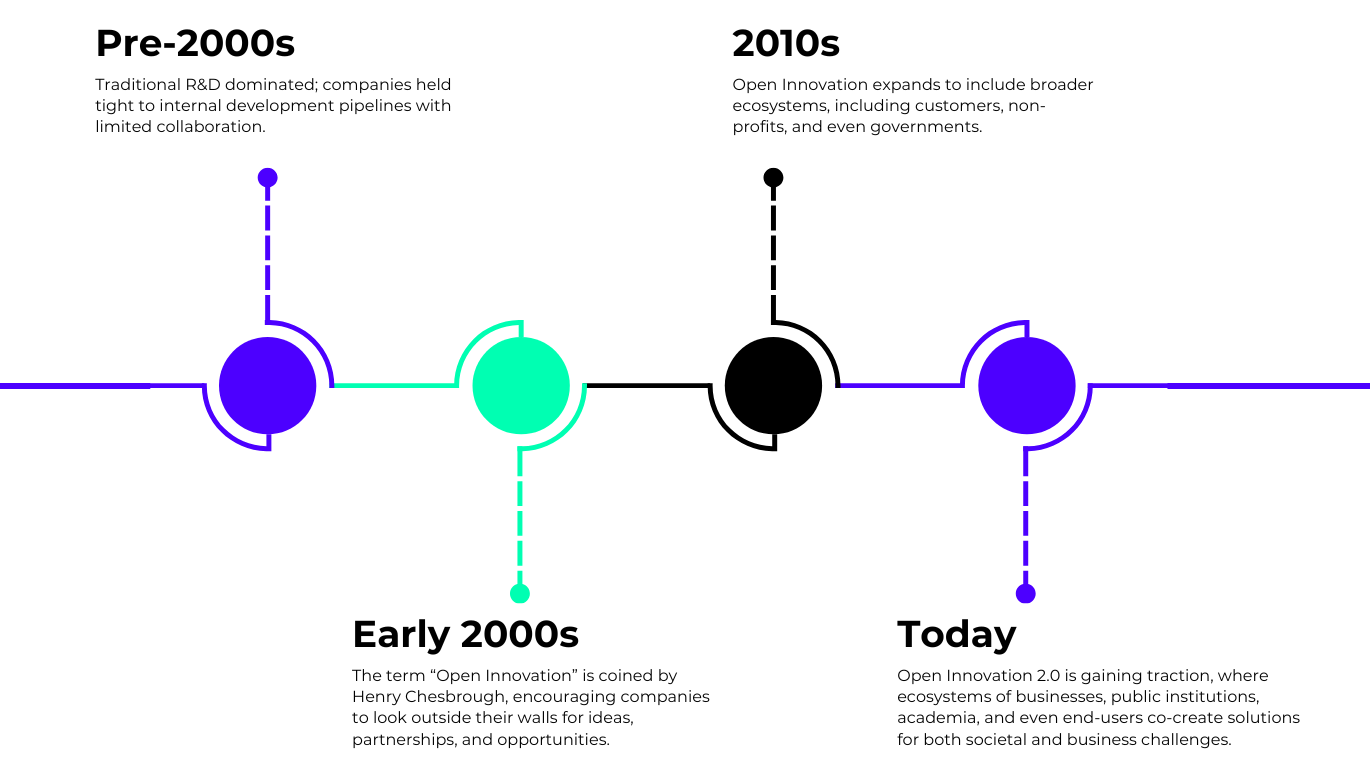In 2008, LEGO took a bold step beyond its own walls with the LEGO Ideas platform. Fans worldwide could submit and vote on new set designs, some of which would go into production. This wasn’t just about new products—it sparked a global community of co-creators, shaping LEGO’s future together. This idea of collective innovation has evolved into Open Innovation 2.0, where companies, communities, and entire ecosystems come together to drive the next wave of breakthrough ideas. Ready to make the leap? Here’s how.
The Evolution of Open Innovation
A quick look at how Open Innovation has evolved into the ecosystem-driven powerhouse that is Open Innovation 2.0 (OI2).

Open Innovation to Open Innovation 2.0

1. From Transactional Relationships to Ecosystem Building
The heart of OI2 lies in an expansive ecosystem of collaborators—businesses, universities, government agencies, and more. Each partner brings unique perspectives and resources, enriching the innovation process.
- Example Insight: Coca-Cola European Partners (CCEP) has created an innovation ecosystem, working with startups, universities, and technology partners to address sustainability and digital transformation.
- Actionable Step: Identify and cultivate partnerships with organisations that complement your innovation goals. Think beyond direct industry peers—look for NGOs, local governments, and research institutions that can contribute unique expertise.
2. Shift to “Win More-Win More” Thinking
OI2 shifts the focus from traditional win-win partnerships to “win more-win more,” where everyone in the ecosystem benefits and contributes to continuous innovation. This collective success mindset expands possibilities and keeps innovation flowing.
- Example Insight: Unilever’s Foundry enables partners to pitch ideas year-round, creating a stream of fresh innovations that evolve alongside market trends.
- Actionable Step: Set up a digital platform or forum where stakeholders, including customers and suppliers, can suggest ideas and offer feedback. Think about how each partner can continue to grow and benefit from the ecosystem, creating a sustainable cycle of innovation.
4. Design for Adoption from the Start
OI2 places the end-user at the centre of the innovation process. Engaging users early on ensures that products meet real-world needs and are designed for adoption from the outset.
- Example Insight: Nivea involved customers in co-creating a stain-resistant deodorant by first understanding their specific pain points and preferences, resulting in a product that addressed an authentic user need.
- Actionable Step: Implement feedback loops where users can test and critique early prototypes. This allows you to refine the product in a way that directly addresses user pain points, increasing its likelihood of adoption.
5. Embrace Cognitive and Multidisciplinary Diversity
OI2 thrives on the diversity of thought and experience. By involving collaborators from different backgrounds and disciplines, companies can avoid groupthink and unlock more creative, effective solutions.
- Example Insight: Siemens actively includes sociologists, environmental scientists, and psychologists in its innovation teams to gain a wider range of insights, especially when tackling complex challenges like smart city planning.
- Actionable Step: Build teams with not only different skill sets but also varied cognitive perspectives. Collaborate with people who might not typically be part of your innovation process, like behavioural scientists or even artists, to introduce fresh viewpoints.
6. Experiment Boldly, Manage Flexibly
In OI2, traditional rigid planning is replaced by continuous experimentation. Instead of controlling every aspect, organisations take on the role of orchestration—guiding a dynamic network of collaborators while remaining flexible and adaptable.
- Example Insight: Spotify’s hackathons provide an informal setting where both employees and external developers can experiment with new ideas. This openness has led to some of Spotify’s most loved features.
- Actionable Step: Encourage internal and external “innovation days” where employees and partners can freely brainstorm and test ideas. Embrace pilot projects and iterative testing as standard practices, allowing for quick adjustments based on real-time feedback.
- Think in “Value Constellations,” Not Value Chains
In OI2, innovation doesn’t follow a linear path. Instead, think of your model as a “value constellation,” where each partner contributes unique resources and ideas in a non-linear, collaborative way to solve complex challenges together.
- Example Insight: In the OI2 model, companies like Natura &Co. work with suppliers, NGOs, and researchers in a collaborative constellation, aligning efforts for environmental and social impact alongside business outcomes.
- Actionable Step: Map out your network’s unique strengths and contributions, and approach projects with a collaborative mindset. Prioritise opportunities for joint problem-solving and co-creation over a traditional “one-way” approach to value creation.
Future-Proofing Your Innovation Strategy
As innovation grows beyond organisational borders, embracing Open Innovation 2.0 is more critical than ever. By expanding networks, focusing on shared values, and embedding diversity, companies can harness the true potential of their ecosystems to create sustainable, impactful solutions.
Interested in how you can make Open Innovation 2.0 a reality at your organisation? Connect with us to find more at joel.wallington@cocubed.com


